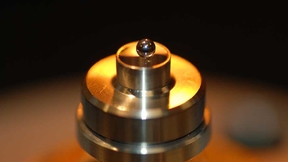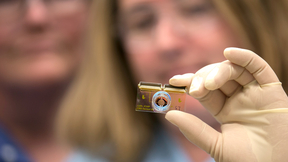Back
Laboratory Directed Research and Development
LLNL team develops new material that bends, bounces and absorbs energy on demand
Scientists at Lawrence Livermore National Laboratory (LLNL) and their collaborators have created a new class of programmable soft materials that can absorb impacts like never before, while also changing shape when heated. The research — which includes collaborators from Harvard University, the California Institute of Technology (Caltech), Sandia National Laboratories and…
Self-driving lab to automate the discovery of novel alloys
Pure metals like aluminum or titanium don’t always have the desired material properties — strength, hardness, ductility or corrosion resistance — for a given application. For this reason, researchers seek out novel alloy solutions, mixing a primary metal element with a series of other elements to create a material with tailored properties for uses in aerospace, defense,…
Breaking down corrosion to predict failure and design stronger materials
You’ve seen the movie scene: dilapidated skyscrapers, collapsed bridges, and empty, shell-like cars in a post-apocalyptic city. While Hollywood imagines fictional causes for this decay, in reality, the culprit is far more mundane: corrosion. Corrosion costs trillions of dollars globally, with up to three percent of the U.S. GDP spent on failing materials. New research from…
Ramping up the scale of climate and energy technology
One of the biggest challenges implementing energy and climate technologies is actually scaling it up to deploy it. While scale-up has largely been the domain of industrial R&D teams, advances in modelling and experimental techniques increasingly allow early-stage researchers like those at Lawrence Livermore National Laboratory (LLNL) to contribute to the process. In a…
LLNL researchers explore next-gen 3D printing to harness fusion energy
When Lawrence Livermore National Laboratory (LLNL) achieved fusion ignition at the National Ignition Facility (NIF) in December 2022, the world’s attention turned to the prospect of how that breakthrough experiment — designed to secure the nation’s nuclear weapons stockpile — might also pave the way for virtually limitless, safe and carbon-free fusion energy. Advanced 3D…
3D-printed electrode is all charged up
The architectural design of electrodes offers new opportunities for next-generation electrochemical energy storage devices (EESDs) by increasing surface area, thickness and storage capacity. But conventional thick electrodes increase ion diffusion length and cause larger ion-concentration gradients, limiting reaction kinetics, including storage capacity. To overcome these…
Evaluating trust and safety of large language models
Amid the skyrocketing popularity of large language models (LLMs), researchers at Lawrence Livermore National Laboratory are taking a closer look at how these artificial intelligence (AI) systems perform under measurable scrutiny. LLMs are generative AI tools trained on massive amounts of data in order to produce a text-based response to a query. This technology has the…
Unveiling the key factors that determine properties of porous polymer materials
Determining the relationship between microstructure features and their properties is crucial for improving material performance and advancing the design of next-generation structural and functional materials. However, this task is inherently challenging. To address the challenges, LLNL scientists developed an efficient and comprehensive computational framework to decipher…
Chemical production gets a cleaner boost
A new electrochemical method can make chemical production cleaner and more energy-efficient. Using thin film nickel anodes, a team of Lawrence Livermore National Laboratory (LLNL) scientists and collaborators have figured out how to clean up chemical production. When studying a new electrochemical reaction, using thin films is important because they give a consistent…
It’s getting hot in here: lasers deliver powerful shocking punch
Shock experiments are widely used to understand the mechanical and electronic properties of matter under extreme conditions, like planetary impacts by meteorites. However, after the shock occurs, a clear description of the post-shock thermal state and its impacts on material properties is still lacking. Lawrence Livermore National Laboratory (LLNL) scientists used ultra…
Magnesium oxide undergoes dynamic transition when it comes to super-Earth exoplanets
Researchers from Lawrence Livermore National Laboratory (LLNL) and Johns Hopkins University have unlocked new secrets about the interiors of super-Earth exoplanets, potentially revolutionizing our understanding of these distant worlds. The focus of this work, magnesium oxide (MgO), a crucial component of Earth’s lower mantle, is believed to play a similar role in the…
Unexpected source of nutrients fuels growth of toxic algae from Lake Erie
Climate change, such as warming and changes in precipitation patterns, affects the frequency and severity of harmful algal blooms (HABs) globally, including those of toxin-producing cyanobacteria that can contaminate drinking water. These nutrient-induced blooms cause worldwide public and ecosystem health concerns. Since the mid-1990s, Lake Erie, the shallowest and warmest…
LLNL researchers develop framework for databasing properties of crystal defects
Point defects (e.g. missing, extra or swapped atoms) in crystalline materials often determine the actual electronic and optical response of a given material. For example, controlled substitutions in semiconductors like silicon are the backbone of modern technology. Despite their importance, point defects are notoriously difficult to simulate and characterize, particularly…
Mystery of puffy exoplanet solved
A recent study of the atmosphere of the exoplanet WASP-107b suggests tidal heating is responsible for the exoplanet’s inflated nature and reveals a previously unseen combination of molecules in an exoplanet. A Lawrence Livermore National Laboratory (LLNL) scientist and international collaborators have characterized the atmosphere of the exoplanet, WASP-107b, using a…
Manufacturing optimized designs for high explosives
When materials are subjected to extreme environments, they face the risk of mixing together. This mixing may result in hydrodynamic instabilities, yielding undesirable side effects. Such instabilities present a grand challenge across multiple disciplines, especially in astrophysics, combustion and shaped charges — a device used to focus the energy of a detonating explosive…
Accelerating material characterization: Machine learning meets X-ray absorption spectroscopy
Lawrence Livermore National Laboratory (LLNL) scientists have developed a new approach that can rapidly predict the structure and chemical composition of heterogeneous materials. In a new study in ACS Chemistry of Materials, LLNL scientists Wonseok Jeong and Tuan Anh Pham developed a new approach that combines machine learning with X-ray absorption spectroscopy (XANES) to…
GUIDE team develops approach to redesign antibodies against viral pandemics
In a groundbreaking development for addressing future viral pandemics, a multi-institutional team involving Lawrence Livermore National Laboratory (LLNL) researchers has successfully combined an artificial intelligence (AI)-backed platform with supercomputing to redesign and restore the effectiveness of antibodies whose ability to fight viruses has been compromised by…
Understanding soil carbon's sensitivity to increasing global temperatures
Particulate soil carbon may be more vulnerable to microbial decomposition under warmer temperatures associated with climate change. Soil organic matter contains more carbon than plants and the atmosphere combined. Soil is increasingly considered for its potential role in climate mitigation due to its ability to sequester more carbon, but it also is critical to understand…
LLNL wins three R&D 100 awards
Lawrence Livermore National Laboratory researchers have garnered three awards among the top 100 industrial inventions worldwide for 2016. The trade journal R&D Magazine announced the winners of its annual awards, sometimes called the "Oscars of invention," Thursday at the Gaylord Convention Center in Washington, D.C. With this year’s results, the Laboratory has now…
'Human-on-a-chip' could replace animal testing
Development of new prescription drugs and antidotes to toxins currently relies extensively on animal testing in the early stages of development, which is not only expensive and time consuming, it can give scientists inaccurate data about how humans will respond to such agents. But what if researchers could predict the impacts of potentially harmful chemicals, viruses or…

























